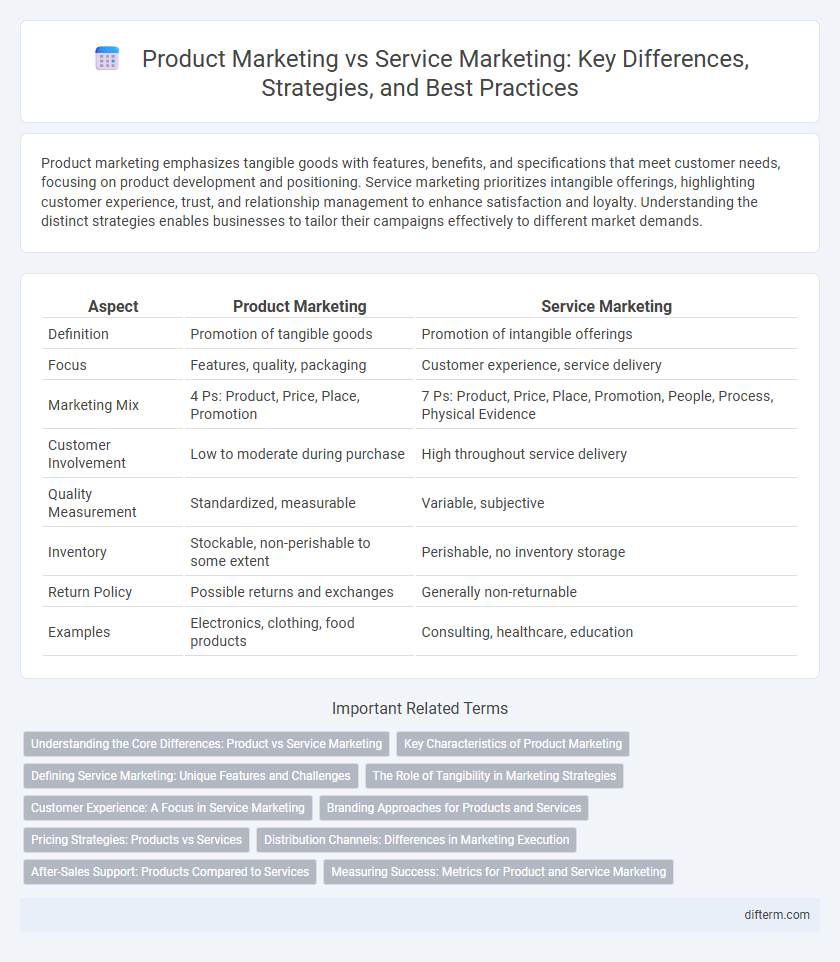Product marketing emphasizes tangible goods with features, benefits, and specifications that meet customer needs, focusing on product development and positioning. Service marketing prioritizes intangible offerings, highlighting customer experience, trust, and relationship management to enhance satisfaction and loyalty. Understanding the distinct strategies enables businesses to tailor their campaigns effectively to different market demands.
Table of Comparison
| Aspect | Product Marketing | Service Marketing |
|---|---|---|
| Definition | Promotion of tangible goods | Promotion of intangible offerings |
| Focus | Features, quality, packaging | Customer experience, service delivery |
| Marketing Mix | 4 Ps: Product, Price, Place, Promotion | 7 Ps: Product, Price, Place, Promotion, People, Process, Physical Evidence |
| Customer Involvement | Low to moderate during purchase | High throughout service delivery |
| Quality Measurement | Standardized, measurable | Variable, subjective |
| Inventory | Stockable, non-perishable to some extent | Perishable, no inventory storage |
| Return Policy | Possible returns and exchanges | Generally non-returnable |
| Examples | Electronics, clothing, food products | Consulting, healthcare, education |
Understanding the Core Differences: Product vs Service Marketing
Product marketing emphasizes tangible attributes such as design, features, and packaging to attract customers, while service marketing focuses on intangible elements like customer experience, reliability, and personalization. Key differences include the perishability and inseparability of services, which require strategies centered around building trust and relationship management. Understanding these core distinctions enables marketers to tailor approaches effectively, leveraging physical evidence for products and service quality assurance for services.
Key Characteristics of Product Marketing
Product marketing emphasizes tangible attributes such as quality, design, features, and packaging that influence consumer purchase decisions. It relies heavily on product differentiation, branding strategies, and lifecycle management to create competitive advantages. Pricing strategies and distribution channels are crucial in product marketing to maximize market reach and profitability.
Defining Service Marketing: Unique Features and Challenges
Service marketing involves promoting intangible products characterized by intangibility, inseparability, variability, and perishability, which require personalized customer interactions and trust-building strategies. Unlike product marketing, service marketing faces challenges such as demonstrating service quality before purchase, managing inconsistent service delivery, and fostering customer loyalty in a highly competitive market. Effective service marketing relies on emphasizing customer experience, relationship management, and customized communication to address these unique features.
The Role of Tangibility in Marketing Strategies
Tangibility plays a crucial role in differentiating product marketing and service marketing strategies, as physical products offer tangible attributes that can be showcased, tested, and demonstrated, thereby enhancing customer trust and perceived value. In service marketing, the intangible nature requires emphasis on experiential elements, such as customer interactions, service quality, and brand reputation, to create reliable mental imagery and foster credibility. Effective marketing strategies leverage tangibility by incorporating sensory cues, physical evidence, and tangible benefits to reduce consumer uncertainty and strengthen purchase decisions.
Customer Experience: A Focus in Service Marketing
Service marketing prioritizes customer experience by emphasizing personalized interactions, emotional engagement, and relationship-building to foster loyalty and satisfaction. Unlike product marketing, which highlights tangible features and benefits, service marketing focuses on intangible elements like responsiveness, empathy, and service quality. Enhancing customer experience in service marketing drives positive word-of-mouth, repeat business, and long-term competitive advantage.
Branding Approaches for Products and Services
Product marketing emphasizes tangible attributes, leveraging visual packaging, logos, and consistent messaging to establish a strong brand identity that appeals to customers' sensory experiences. Service marketing focuses on building trust and emotional connections through personalized customer interactions, reputation management, and delivering consistent service quality to reinforce brand reliability. Both approaches prioritize differentiation, but product branding highlights physical features while service branding centers on experience and customer relationships.
Pricing Strategies: Products vs Services
Product marketing pricing strategies often rely on cost-plus pricing, competitive pricing, and value-based pricing due to tangible production and inventory costs. Service marketing pricing emphasizes dynamic pricing, subscription models, and bundling, reflecting intangibility, variability, and customer experience factors. Understanding these differences helps tailor pricing approaches to maximize revenue and market positioning in each domain.
Distribution Channels: Differences in Marketing Execution
Product marketing relies heavily on physical distribution channels such as retail stores, wholesalers, and direct sales to ensure tangible goods reach consumers efficiently. Service marketing emphasizes digital platforms, personalized customer interactions, and direct communication channels to deliver intangible value experiences. Effective marketing execution tailors distribution strategies to the inherent nature of products or services, optimizing customer reach and satisfaction.
After-Sales Support: Products Compared to Services
After-sales support for product marketing often involves warranty services, product repairs, and replacement parts to ensure customer satisfaction and maintain brand loyalty. In service marketing, after-sales support focuses more on ongoing customer engagement, personalized assistance, and problem resolution to enhance the overall customer experience. Effective support mechanisms in both product and service marketing influence repeat purchases and positive word-of-mouth, driving long-term business growth.
Measuring Success: Metrics for Product and Service Marketing
Product marketing success is often measured by metrics such as sales volume, market share, customer acquisition cost, and product usage rates, reflecting tangible consumer adoption and revenue generation. Service marketing metrics emphasize customer satisfaction scores, client retention rates, service quality ratings, and Net Promoter Score (NPS) to capture ongoing value and relationship strength. Both approaches rely on data-driven insights but differ in prioritizing transactional outcomes for products versus experiential and relational outcomes for services.
product marketing vs service marketing Infographic

 difterm.com
difterm.com